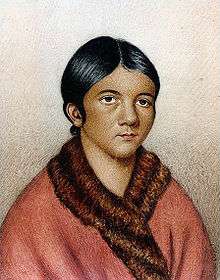Demasduit



Demasduit (c. 1796 – January 8, 1820[3]) was a Beothuk woman, one of the last of her people on the island of Newfoundland, Canada.
She was born near the end of the 18th century. The Beothuk were defending themselves from Europeans, and violent conflicts between them were common. The conflicts usually took more Beothuks than Europeans, which led to their decline. These new settlers also had taken up residence in the coastal areas, which hindered the Beothuks' access to food resources near the coast.
In the fall of 1818, a small group of Beothuks had taken a boat and some fishing equipment at the mouth of the Exploits River. The governor of the colony, Charles Hamilton, authorized an attempt to recover the stolen property. On March 1, 1819, John Peyton Jr. and eight armed men went up the Exploits River to Red Indian Lake in search of Beothuks and their equipment. A dozen Beothuk fled the campsite, Demasduit among them. Bogged down in the snow, she exposed her breasts, a nursing mother, begging for mercy. Demasduit was captured; Nonosbawsut, her husband and the leader of the group, was killed while attempting to prevent her capture. Her infant son died a few days after she was taken.
Peyton and his men were absolved of their murder by a grand jury in St. John's, the judge concluding that, "..(there was) no malice on the part of Peyton's party to get possession of any of (the Indians) by such violence as would occasion bloodshed."
Demasduit was taken to Twillingate and for a time lived with the Church of England priest, the Reverend John Leigh. He learned that she was also called Shendoreth and Waunathoake, but he renamed her Mary March, after the Virgin Mary and the month in which she was kidnapped.
Demasduit was brought to St. John's and spent much of the spring of 1819 in St. John's, brought there by Leigh and John Peyton Jr. While there, Lady Hamilton painted her portrait.
During the summer of 1819, a number of attempts were made to return her to her people, without success. Captain David Buchan was to go overland to Red Indian Lake with Demasduit in November, the people of St. John's and Notre Dame Bay having raised the money to return the Beothuk to her home. She died of tuberculosis at Ship Cove (now Botwood) aboard Buchan's vessel, the Grasshopper, on January 8, 1820. Her body was left in a coffin on the lakeshore, where it was found by members of her tribe and returned to her village in February.[4] She was placed in a burial hut beside her husband and child. There were only thirty-one of the Beothuk remaining at that time.
Demasduit's niece, a young woman named Shanawdithit (1801–1829), was the last known Beothuk.
The song "Demasduit Dream", recorded by Newfoundland band Great Big Sea, describes this incident.
The Mary March Provincial Museum in the town of Grand Falls-Windsor, Newfoundland and Labrador, is named after her. In May 2006, a group of local grade 2 students, led by student Connor O'Driscoll, helped collect more than 500 signatures on a petition to rename the museum to reflect Demasduit's real identity, rather than the name she was given after her capture.
See also
The novel "River Thieves" by Michael Crummey explores this part of Newfoundland history (cf).
References
- ↑ Charlotte Gray 'The Museum Called Canada: 25 Rooms of Wonder' Random House, 2004
- ↑ Mullen, Gary R., "Philip Henry Gosse," Encyclopedia of Alabama, 26 August 2008, retrieved 9 September 2011
- ↑ G. M. Story. "DEMASDUWIT". University of Toronto/Université Laval. Retrieved October 2, 2013.
- ↑ MacLean, John. "Canadian Savage People", 1896. pp 318.
External links
- Biography at the Dictionary of Canadian Biography Online
- Article on petition to rename the Mary March Museum on CBC News Online
- Ideas on CBC program about Demasduwit
|